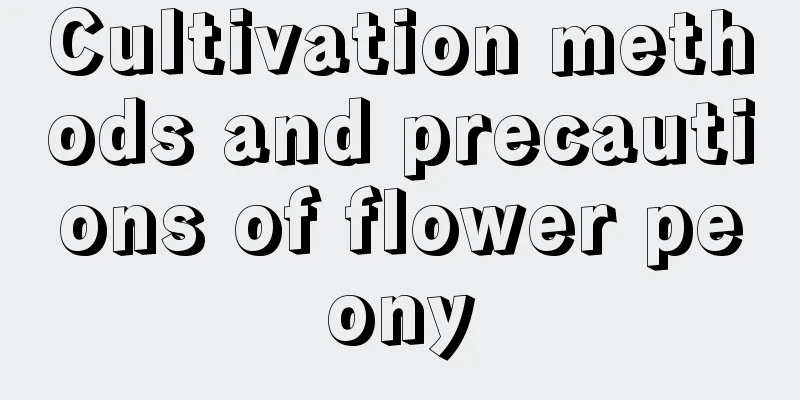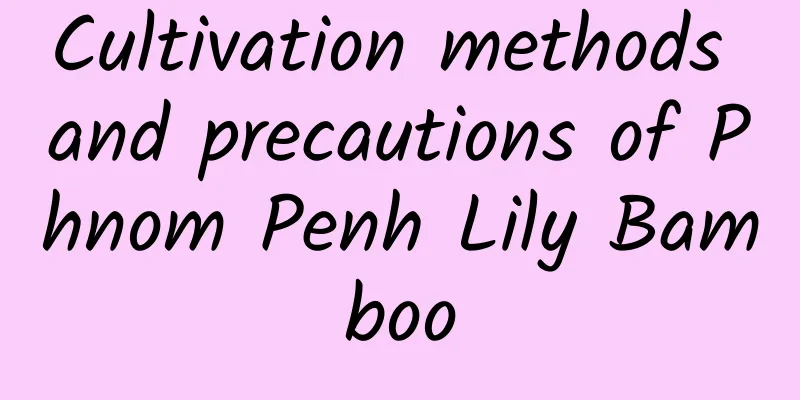Cultivation methods and precautions of flower peony

1. Maintenance methods1. Temperature: Judging from its origin and distribution area, it prefers higher temperatures, specifically between 20 and 32 degrees. If the temperature is too high, its leaves will easily wither, so it should not exceed thirty-five degrees. Some varieties have good cold resistance and can withstand temperatures as low as minus eight degrees Celsius, but some are also more afraid of the cold. 2. Light: Peonies love light very much, and only need shade when the light is too strong. Generally speaking, there is no need for shade except in summer. In summer, the light cannot be completely blocked, and the shading degree should be kept at around 50%. 3. Watering: Although peony likes moisture, it is also afraid of waterlogging. Therefore, it can be adjusted according to drought and flood conditions. During dry spells, water more often to keep the plants moist. But when there is a lot of rain, we must pay attention to drainage. 4. Fertilization: It has a longer flowering period and more leaves, so it requires more fertilizer. In addition to base fertilizer, try to use liquid fertilizer once or twice a month, especially during the flowering period. 2. Breeding techniques1. Repotting: Peonies grow faster during the growth period and consume more nutrients during flowering. Therefore, try to change the soil every year. Mountain soil can be used as the main matrix and mixed with materials such as sawdust. In addition, base fertilizer is still relatively important, and available ones include animal manure, cake fertilizer, etc. 2. Pruning: Peonies grow fast, so pruning is very important, and the plants are relatively resistant to pruning. Generally speaking, you can pinch off the tips of the flowers in spring to ensure more flowers bloom later. Before entering winter, it is best to prune, mainly cutting off old and dry branches and leaves. 3. Problem diagnosis and treatment1. Disease: There is "soot mold", which seriously affects the branches and leaves, especially the leaves, affecting their photosynthesis. Thiophanate can be used for prevention and treatment. There is also "anthracnose", which spreads very quickly and needs to be prevented and treated with Bordeaux in time. 2. Pests: Mainly "nematodes", which harm the roots. It is very important to disinfect the soil. IV. Other issues1. Flower language: The meaning of peony is good, including "humility", "virtue", "sincerity" and so on. 2. Can it be raised at home? Yes, it has a good ornamental effect. |
<<: Cultivation methods and precautions of Magnolia officinalis
>>: Cultivation methods and precautions of Dendrobium officinale
Recommend
How to plant hydrangeas? When and how to plant them
When to plant hydrangeas Hydrangeas are best plan...
Kirin Palm soil changing time and method
Kirin Palm soil replacement time It is generally ...
How to prune jasmine? What to do if the leaves wilt?
1. Methods 1. The time can be chosen before the b...
Can rose seeds be planted?
1. Is it possible? No matter what plant it is, se...
Tips to permanently get rid of ants. What are ants afraid of?
1. Rubber Band Ants are afraid of the smell of ru...
How to grow big pumpkin and what to pay attention to
1. Soil The big pumpkin does not have very high r...
Can I water the Christmas cactus after transplanting?
1. Can I water it? Whether Christmas cactus can b...
How to Plant Asparagus Seeds
Asparagus seeds can be planted in spring from Mar...
A complete guide to grapevine diseases
Grapes are a very popular fruit . The southern re...
Maintenance tips for cherry potted plants
How to care for cherries Water and fertilizer Whe...
Hyacinthus growth environment conditions and characteristics
Hyacinthus growth environment conditions and requ...
Don’t worry if the leaves of the green radish turn yellow. Just bury 2 or 3 soybeans in the soil and they will come back to life in a few days!
But recently, a flower lover came to tell Huahua ...
What is the matter with dried mint leaves
1. Lack of water 1. Reason: Mint requires relativ...
What to do if potted lemon drops leaves
Just bought it home Many times, the green plants ...
Pepper sowing time and method
Pepper is an annual or perennial plant, and the c...









